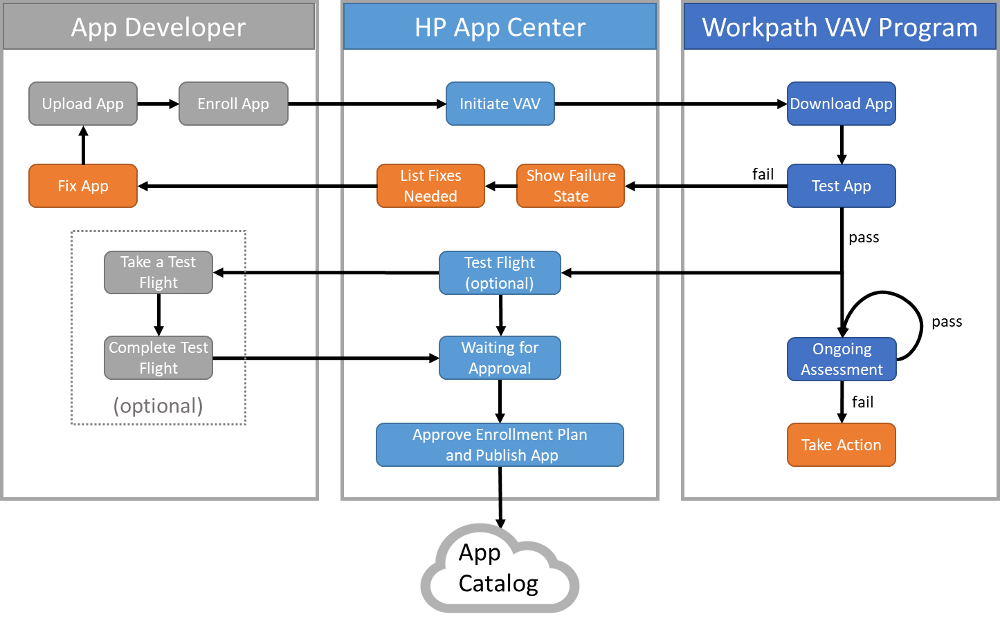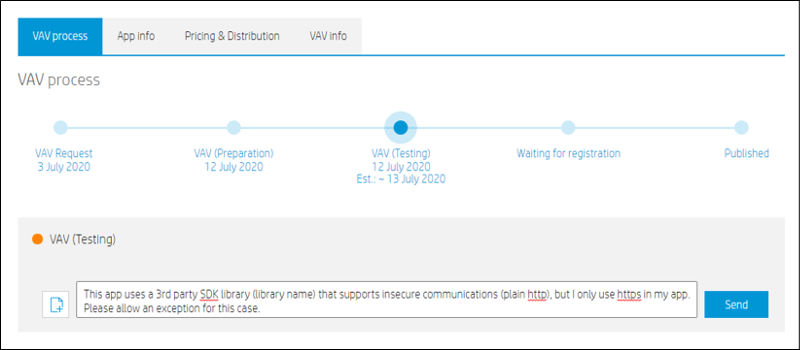Enrolling and Publishing Apps
Any app intended for use on any HP device must be specially packaged, submitted to HP for verification and validation (VAV), and finally signed by HP before it can be installed on a device.
Note: HP's VAV testing focuses mostly on security, and uses as its foundation the same recommendations for Android apps, which are described here. In addition, there is a VAV checklist and sample VAV report (showing some of the most commonly reported issues) available here. Please make sure these guidelines have been followed before submitting your app for VAV testing.
To publish an app, you will need to create a publishing account on the HP App Center. When signing up, please read the App Center terms and conditions carefully.
The first account created for your company will be the Master Admin account (used to manage the company's tenant within the App Center). The Master Admin can then invite other members of your company to participate in app publishing activities with different roles such as:
- Admin - Can manage payment plans, apps, and users
- App Developer - Can initiate the app submission process
- Business Owner - Can manage payment plans, finalize the enrollment plans, finalize the app submission process, and manage the app portfolio
Note: There can be only one Master Admin for your company. However, the Master Admin can transfer the role to another user if necessary.
(Note: This page is intended only as a brief guide. For detailed instructions on using App Center, please see the App Center Manual.)
To publish an app, follow these steps (which will be explained in detail below):
- Package your app as an HPK and test it on a device with LDB enabled
- Register and upload your app (HPK) on App Center
- Enroll your app
- Pass VAV
- Take a Test Flight (Optional)
- Publish your app
- Manage your published app
The following diagram describes the enrollment and publishing process at a very high level. Please see the App Center Manual for details.

Step 1. Package Your App as an HPK
Any app intended for use on any HP device must be specially packaged into an HPK file. The SDK contains an HPKTool for this purpose. A HPK file includes your signed APK and provides app-related information not present in a standard APK file. A HPK file intended for VAV and publishing must include the signed/release version of your APK. (Note: The APK must be signed using V1 JAR Signature, SHA256 or greater.)
Note : The HPKTool will also allow you to test the installation of an unsigned HPK on devices where LDB is enabled (the APK must still be signed). See Installing and Debugging Your App and the HPKTool User Guide in the SDK for more information.
Step 2: Register and Upload Your App on App Center
To register and upload your app on App Center, follow these steps:
A. In the Apps view, Click Register new app
B. Click Browse and pick your HPK file
C. Complete the app and VAV information form
D. Upload the app

Step 3: Enroll Your App
Now that your HPK is uploaded, you can enroll it and submit it to HP for VAV.
Note: The choice of an enrollment plan is a usually business decision. To help your business team make an informed decision, please have them carefully review all of the information provided on the HP Workpath page.
Note: Enrollment plans that have associated fees will require you to provide credit card information to complete the enrollment.
Note: Enrolling an app into the Transacted plan for the first time will require you to complete an underwriting process to receive an Affiliate ID.
Note: Once an enrollment plan is chosen and approved, it can only be changed by HP upon receiving a written request and approval. You can use a private post in the support forum to initiate a change request.
Follow these steps:
A. Choose an enrollment plan
B. Choose publication options
C. Enroll
D. Agree to terms
E. Click OK


Step 4: Pass VAV
Once enrolled, your app will be automatically submitted for VAV. You can check the status of all submitted apps from the Requested Apps page.

If you have questions or supporting information you want to provide pertaining to the VAV process for your app, the VAV section of the app details page includes a notification feature to facilitate two-way communication with the VAV team.

Note: Some enrollment plans specify a limit on the number VAV tests to be performed per year. This is a limit on the number of successful test rounds, not failed test rounds.
If your app fails VAV, you will be notified in App Center and will be provided with a list of required fixes in test report attached to the VAV Info section of the app details page. Fix the reported issues and resubmit your for revalidation.
If your app passes VAV, HP will sign your HPK and it will be ready to be published and installed.
Step 5: Take a Test Flight (Optional)
As an app developer, you will be granted access to HP Command Center (HPCC). There you can take your app on a "test flight" to see how your app is being shown in the catalog and install/configure/demo it on a small number of real devices (Demo Pool) before anyone else can see it in the catalog. You can also install/configure/demo any of your previously published apps as well as a select set of HP apps on devices in the Demo Pool.
See Command Center and Test Flight for details.
Step 6: Publish Your App
HP will publish the app into our global app catalog, making it available for subscription and installation through HP Command Center. (Note that within App Center you can limit visibility/distribution of your app to specific countries and/or regions, or even to individual Service Providers.)
Service Providers will connect their customers' devices to HP Command Center, and then through HP Command Center they will find your app in the catalog, add your app to their portfolio (subscribe), and install your app on their customers' devices.

Step 7. Manage Your Published App
You can manage your published app withhin App Center as follows:
- Edit your app's information (Changes will be automatically reflected in the app catalog.)
- Create and publish new versions of your app (Every new version must go through VAV.)
- Remove your app from the system (Your app will be removed from the app catalog, all information about it will be archived, and it will no longer be visible in your account view. Note that the AppId, AppName, and Package Name of a removed app cannot be reused for another app.)